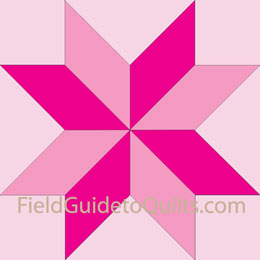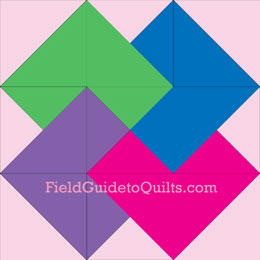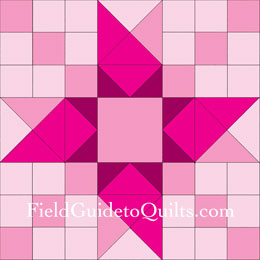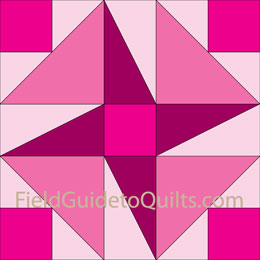If a block owes its name to a particular arrangement of colors, we include it as a unique block whether or not the pattern is unique. That's why you'll find all four variations of Circling Swallows, as well as Polk Ohio and Pin Wheel, listed separately on this page. It's also why Card Trick's two variations, like fraternal twins, are listed under the same name below.
Enigma
 Enigma
The Ladies Art Company's 1897 catalog had 400 blocks, or so we're told. That makes Enigma, #400, the last LAC block to see print in the 19th century.
In 1937, Chicago Tribune columnist Nancy Cabot published a similar block with a slightly smaller center star and called it Star Puzzle. Columnist Nancy Page called it North Star in 1939.
Enigma is drafted on a star grid with four lines running through the center of the block. The star points are located where those lines cross two circles. One circle is the full width of the block and the other is half the width of the block. You don't see the circles on the finished block.
Like so many other LAC blocks, the illustration was in two colors, dark and light, and was very likely meant to be made with dark- and light-colored scraps. We've branched out to three colors in our mockups.
If you've stumbled across this block when you were looking for Nancy Cabot's Enigma Square, click here: 
Here's how you can draft your own Enigma block. 
|
|
Flying Bat
 Flying Bat Flying Bat
LAC #44
1897
We've swapped the light and dark colors from the LAC's illustration so you can see the diamonds. Why diamonds if they're all the same color? They're supposed to be scraps of similar colors, probably.
|
Polaris Star
 Polaris Star Polaris Star
Hall
1935
If you use only one fabric for the diamonds in Flying Bats, Carrie Hall's variation, Polaris Star, is far simpler to make. She stitched up a Polaris Star block for a collection that is now in the Spencer Museum at the University of Kansas in Lawrence, Kansas. She made it in three colors, like our graphic.
North star, pole star, and Polaris are names for the real-life star that is closest to the invisible axis on which Earth spins, and thus, stays in the same place in the sky from sundown to dawn — an essential navigation point for millenia. As Hall traveled country roads to do block research in the 1920s, she would have seen the full majesty of the night stars in an unlit rural landscape. |
|
Circling Swallows
 Circling Swallows Circling Swallows
Finley
1929
Circling Swallows has been around since about 1800, according to quilt historian Ruth Finley (Old Patchwork Quilts, 1929). She said it was popular in New England and Pennsylvania.
Nowadays the block usually goes by Circling Swallows. Finley called it Falling Star; Circling Swallows and Flying Star were alternate names; almost 60 years later, Yvonne Khin (Collector's Dictionary, 1988) added the name Rolling Star.
Any of these blocks can be made with the instructions you'll see when you click the "Make it!" icon. And if you don't like that how-to, there are plenty more on the web.
|
Flying Swallow
 Flying Swallow Flying Swallow
LAC
1928
The Ladies Art Company called this two-color star Flying Swallow in 1928 (#503). The star and background are one color and the triple diamonds are in the second color.
In 1933, Laura Wheeler called the same block Wreath.
|
Whirling Star
 Whirling Star Whirling Star
Kansas City Star
1937 Whirling Star Whirling Star
|
Falling Star
 Falling Star Falling Star
Kansas City Star
1937
In their 1935 book, quilt researchers Carrie Hall and Rose Kretsinger called a four-color variation of Circling Swallows by two of the same names Finley included as alternatives. The block is pictured at left. Hall stitched up a block of this design and included it in a comprehensive collection of quilt blocks that is now in the Spencer Museum of Art at the University of Kansas in Lawrenceville, Kansas.
|
|
Godey's Design
 Godey's Design Godey's Design
Godey's Ladies Book
1858
|
|
Fish Tails
 Fish Tails Fish Tails
Stone (as Double Star)
1906
The Fish Tails block was originally published as Double Star in Practical Needlework by Clara Stone (1906). The far more memorable name that we're using is from an identical Nancy Page block published in 1933. |
|
Star Flower
 Star Flower
Q Book 112 Star Flower
Q Book 112
This basic design seems to have only one name, and nobody knows what it is except a few experts. Jinny Beyer is one of them. She cites Q Book 112: One Piece Quilts for the name Star Flower in her Quilter's Album of Patchwork Patterns (2009).
|
|
Pin Wheel
 Pin Wheel
Orange Judd Farmer Pin Wheel
Orange Judd Farmer
1899
|
Orange Judd
Patron of the quilting arts |
Star of the Milky Way/Twinkle Star/LeMoyne Star & Windmill
Both Pin Wheel and Polk Ohio are based on star grids, but Pin Wheel is older. Its debut was in the Orange Judd Farmer in 1899, according to Barbara Brackman.
Orange Judd was the long-time editor of American Agriculturist, which he bought from its founders in 1856. Later, his publishing company bought an existing magazine for farmers and named itOrange Judd Farmer. Orange Judd & Co. also published Hearth and Home for three years.
All three magazines published quilt blocks, which, in agricultural journals, were a nod to the farmer's wife. If Judd had known that he'd be remembered more than a hundred years after his death as a patron of the quilting arts, he'd probably have been shocked.
|
Polk Ohio
 Polk Ohio
Nancy Page Polk Ohio
Nancy Page
1939
Nor do we know how the colors in Page's block were arranged. We'd love to hear from anyone who knows.
We've shown a two-color version. |
|
Unfolding Star
 Polk Ohio
Nancy Page Polk Ohio
Nancy Page
1939
The frou-frou around the octagon may seem beside the point, but it creates an interesting pattern on a quilt top.
<
|
|
Waltzing Matilda
 Polk Ohio
Nancy Page Polk Ohio
Nancy Page
1939 |
|
Card Trick
 Card Trick Card Trick
 Polk Ohio
Nancy Page Polk Ohio
Nancy Page
1939 Card Trick Card Trick |
|
 |
|





















 Enigma
Enigma 
 Flying Bat
Flying Bat Polaris Star
Polaris Star
 Circling Swallows
Circling Swallows Flying Swallow
Flying Swallow  Whirling Star
Whirling Star  Whirling Star
Whirling Star Falling Star
Falling Star
 Fish Tails
Fish Tails
 Pin Wheel
Pin Wheel
 Polk Ohio
Polk Ohio
 Polk Ohio
Polk Ohio

 Card Trick
Card Trick